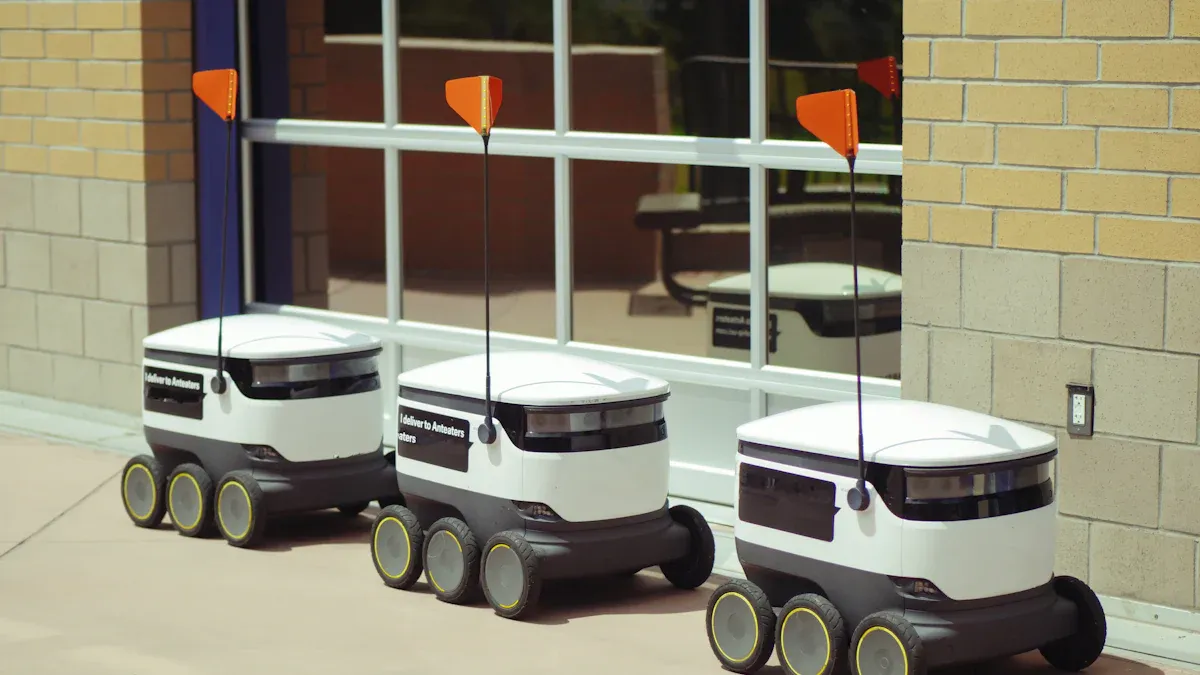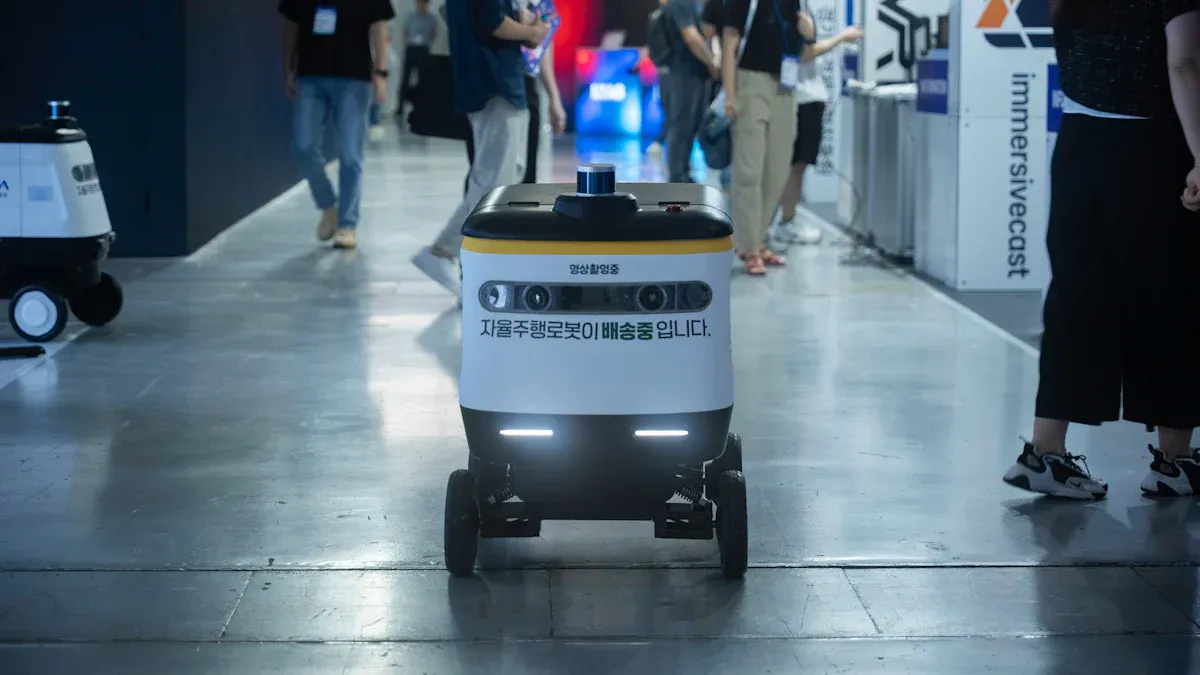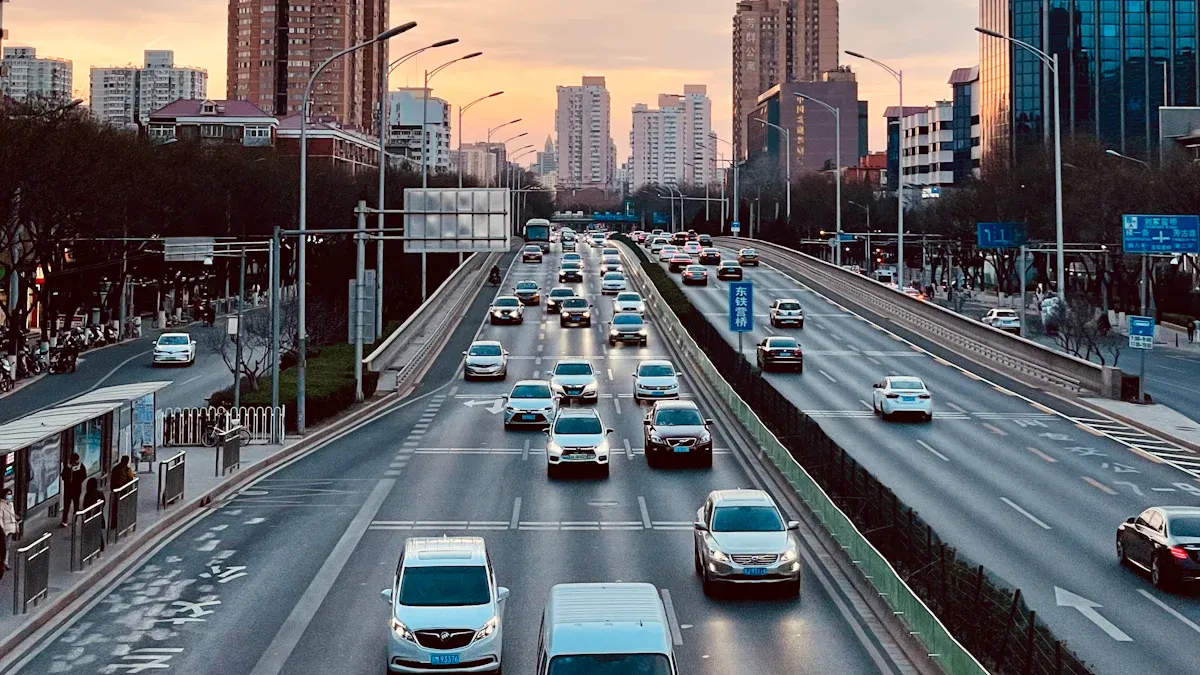The race for dominance in autonomous stores between China and the US

You can see that China is ahead in autonomous store technology, highlighting the ongoing US tech competition. When you enter a BingoBox in China, you join many people who utilize more than 300 automated stores. In the US, you might visit one of 46 checkout-free stores operated by a major tech company. The competition between China and the US significantly influences shopping and AI-powered business globally. Government regulations, market dynamics, and innovative ideas drive this tech race, transforming how you shop and engage with technology.
Key Takeaways
China has more autonomous stores than the US. China has over 300 stores. The US has only 46 stores. This shows a big tech race between the two countries.
Big companies like Alibaba and Amazon are changing how people shop. They use new technology to make shopping quicker and easier.
The Chinese government helps autonomous stores grow fast. US companies have fewer rules but focus more on new ideas.
People in different places accept autonomous stores in different ways. How easy the stores are and how much they cost matter to shoppers. These things affect if people want to try autonomous stores.
New things like AI and cashless payments are changing shopping. Experts think the market will get much bigger by 2030.
Who Leads in Autonomous Stores?

Market Leaders Today
When you look at autonomous stores, you see big companies and new ones. In China, Alibaba Group Holding Limited and BingoBox changed shopping. They use smart cameras and sensors. Artificial intelligence helps you shop without waiting in line. You walk in, pick up items, and leave quickly. In the United States, Amazon.com Inc. leads with Amazon Go stores. These stores use advanced technology. They track what you take and charge you automatically.
There are other important companies too. Some focus on technology. Others run stores or help businesses go cashierless. Here are some main companies shaping autonomous retail:
Amazon.com Inc.
Alibaba Group Holding Limited
7-Eleven Inc.
Panasonic Holdings Corporation
Toshiba Corporation
Trigo Group
Scandit AG
Zippin
Delfi Technologies
Accel Robotics Corporation
Turck Vilant Systems Oy
AiFi Inc.
Sensei LLC
SandStar
Wheelys
PIXEVIA
Grabango
MishiPay Ltd.
Pick and GO
Cloudpick AI
Both China and the US have strong companies. Amazon and Alibaba are leaders. Many smaller companies help push technology forward. Big companies and startups make the us tech competition busy.
Note: Many of these companies do more than run stores. Some give technology to other brands for autonomous shopping worldwide.
Key Milestones
You can follow the growth of autonomous stores by looking at important events. In 2016, Amazon opened its first Amazon Go store for employees in Seattle. This was a big change for retail. By 2018, Amazon Go opened for everyone. Shopping became fast and easy without cashiers.
In China, BingoBox started its first fully automated store in 2016. Soon, Alibaba launched Hema stores. These stores mix online and offline shopping. They use facial recognition, mobile payments, and smart shelves. This makes shopping smooth and efficient.
Here are some key moments for autonomous stores:
2016: Amazon Go opens its first test store in Seattle.
2016: BingoBox starts in China, bringing cashierless shopping to more cities.
2017: Alibaba opens its first Hema store with smart technology.
2018: Amazon Go opens to the public in more US cities.
2019: Zippin and AiFi help other retailers open autonomous stores in airports and stadiums.
2020: China gets hundreds of BingoBox and Hema stores.
2021: US and Chinese companies expand their technology to Europe and other places.
Both countries made big progress quickly. China has more autonomous stores. The US leads in advanced technology. The us tech competition keeps going as both sides try to shape the future of shopping.
China vs US: Strategies
Government Support
Government support is important for autonomous stores in both countries. In China, the government helps new retail technology grow. It puts money into smart cities and backs companies using artificial intelligence. This help lets companies like Alibaba and JD grow quickly. In the US, the government does not get very involved. Private companies lead and make their own choices. They have fewer rules but do not get much help from the government. Because of this, new stores open at different speeds in each country.
Market Approaches
Chinese and US companies use different ways to do business. Chinese companies mix online and offline shopping. They use data to keep track of products and help shoppers. Many stores in China help small shops use digital tools. Alibaba gives small stores a full retail system with data, delivery, and money services. JD and Tencent work together to make shopping without borders. Lenovo and Xiaomi make stores better with data and new technology.
Here is a table that shows some business models:
Company | Business Model Description |
|---|---|
Alibaba | Full retail system with data, delivery, and money services for small stores |
JD | Shopping without borders using data from JD and Tencent |
Lenovo | Stores that use data to connect online and offline sales |
Xiaomi | Stores that use technology to make shopping better |
Amazon | Uses technology to change how people shop in stores in the US |
In the US, companies like Amazon use technology to make shopping faster. They show how tech companies can change stores. This makes the us tech competition stronger and pushes others to try new things.
Many Chinese companies help small stores use digital tools. US companies usually build big, high-tech stores.
Innovation Focus
Both countries care about new ideas, but they focus on different things. Chinese companies use data to run stores and help small shops. They want to make every part of shopping digital. US companies, like Amazon, spend money on sensors and artificial intelligence. They want shopping to be fast and easy. This focus on technology makes the us tech competition more exciting and changes stores everywhere.
Chinese companies:
Mix online and offline shopping.
Use data to track products and customers.
Help small shops use digital tools.
US companies:
Spend money on sensors and AI.
Make shopping quick and without cashiers.
Change stores around the world with new technology.
These different ways make the race between China and the US interesting. Each country uses what it is good at to lead the future of autonomous stores.
Strengths and Weaknesses
Innovation & R&D
Both China and the US spend a lot on research for autonomous stores. Chinese companies are putting more money into R&D now. In early 2025, A-share firms in China spent over 810 billion yuan, which is about $113 billion. This is 3.27% more than last year. BYD increased its R&D spending by 53%, even though profits went down a bit. China has 5.01 million valid invention patents. Most of these belong to businesses. China’s high-tech exports also went up by 9.2%. These facts show Chinese brands are getting stronger worldwide.
Cost & Scalability
Making more autonomous stores means using smart tech and saving money. Here is how companies in China and the US do it:
Company | Approach to Scaling Autonomous Stores | Key Technologies Used | Performance Metrics |
|---|---|---|---|
Walmart | Focus on automation in fulfillment and distribution | Robotics, AI, Data Analytics | 99.9% order accuracy, 25% reduction in processing time |
Alibaba | Emphasis on innovation and integration across diverse business models | AI, Robotics, IoT | 99.8% delivery accuracy, 40% of sales from recommendation algorithms |
Alibaba uses artificial intelligence and robotics to link many store types. Walmart uses automation to make orders more accurate and faster. Both countries want bigger and better stores, but they use different ways.
Regulatory Challenges
There are many rules when building autonomous stores. In the US, the ICTS rule makes using advanced driving tech harder. This rule adds more work for makers of connected vehicles and autonomous systems. Federal motor safety standards can also slow down new vehicle designs. In China, some companies look to Europe because of limits in the US market. These barriers change how fast companies grow and affect the us tech competition.
Note: Rules and standards can slow new tech, but they also keep shoppers safe and protect people.
Global Expansion & Market Impact

Consumer Adoption
People in different countries react to autonomous stores in their own ways. In China, most shoppers feel okay using stores without cashiers. In the US, not as many people trust the technology. Many worry about safety and privacy. In Europe, friends and family can help you decide to try new shopping. The table below shows what matters most to shoppers in each place:
Region | |
|---|---|
USA | Ease of use, Cost considerations, Perceived risks |
Europe | Ease of use, Cost considerations, Social influences |
Asia | Ease of use, Social influences |
If the technology is easy and the price is fair, people want to use it. If the store saves time and money, shoppers will come back.
International Moves
Chinese and US companies are moving into Europe and the Middle East. Chinese firms like QCraft and Momenta have offices in Germany. They test new systems and want to sell them soon. Momenta works with Uber to try new vehicles in Germany. Pony.ai and Stellantis test robotaxis in Luxembourg. Lyft and Baidu want to launch autonomous vehicles in Germany and the UK. Chinese companies also work with Dubai and Saudi Arabia to try new technology. These moves show they want to grow around the world.
QCraft builds offices in Germany.
Momenta works with Uber in Europe.
Lyft and Baidu go to Germany and the UK.
Competitive Dynamics
The us tech competition changes the global market. Chinese companies get help from their government and have easier rules. This helps them grow fast and gain trust from shoppers. US companies focus on safety and being open. They run public tests and talk to rule makers. Problems like payment errors or system mistakes can hurt a store’s reputation. Worries about privacy and less human contact may stop some people from using these stores. Cyber threats also make companies work hard to keep your data safe. The race between China and the US makes everyone try to make better technology and improve shopping.
Future of US Tech Competition in Autonomous Stores
Emerging Trends
Many new trends are shaping autonomous stores in the US. The market is growing fast and could be worth $32.2 billion by 2030. Stores use more AI and Internet of Things (IoT) devices now. These tools help make shopping smarter and easier for everyone. Shoppers want quick and simple trips, so stores focus on speed and ease. Cashless payments are becoming normal, with mobile apps and self-checkout leading. Many stores are open all day and night, which helps busy people and saves money on workers.
Trend | Description |
|---|---|
Market Growth | Unmanned stores could be worth $32.2 billion by 2030. |
Technology Integration | AI and IoT help make shopping easier and smarter. |
Consumer Preferences | Shoppers want fast and easy experiences. |
Cashless Payments | More people use mobile apps and self-checkout. |
24/7 Availability | Stores stay open all day, saving money on staff. |
Agentic AI is also changing how stores keep track of products. As technology gets better, shopping will keep changing.
Policy & Influence
Government rules help shape the future of autonomous stores in the US. Friendly rules let companies test and use new technology. The US wants to stay ahead of China, so rules focus on new ideas and safety. The Department of Transportation made rules for autonomous vehicles, which also help store technology. Programs like AV TEST let companies test safely and share what they learn.
Aspect | Description |
|---|---|
Regulatory Environment | |
Competition with China | Rules try to keep the US ahead in tech. |
National Security | AI and automation are important for US safety and leadership. |
These rules help the us tech competition grow and keep things safe and fast.
What Could Shift the Balance
Many things could change who leads in the us tech competition. If trade rules change, US companies could get a bigger part of the market. Selling more and buying less from China could help US companies make more money. This extra money would help pay for new ideas and technology. The US is behind China in some high-tech areas, so these changes are important.
More exports and fewer imports from China can help US companies earn more.
More money helps support new ideas in autonomous stores.
You also have a part to play as a shopper. Your trust and choices will help decide which country leads next.
China is ahead in autonomous stores. This is because the government helps a lot. They also come up with new ideas quickly. Chinese companies move fast to other countries. The US cares more about using advanced technology. They also focus on keeping things safe. It is important how much things cost and how fast companies grow. New ideas also matter a lot. You should pay attention to new rules and new technology. Watch what companies do around the world. The us tech competition will keep changing how you shop in the future.
FAQ
What is an autonomous store?
You shop in an autonomous store without cashiers. Smart cameras, sensors, and AI track what you buy. You pay automatically when you leave. These stores save you time and make shopping easy.
Why does China have more autonomous stores than the US?
China’s government supports new technology. Companies get help to build stores quickly. You see more stores in China because they grow fast and test new ideas often.
Are autonomous stores safe for your privacy?
Most stores use strong security to protect your data. You should check each store’s privacy policy. If you worry about privacy, ask staff or read signs before you shop.
Tip: Always use trusted payment apps and keep your device secure.
Will autonomous stores replace all regular stores?
You will still find regular stores. Autonomous stores grow fast, but not everyone likes them. Some people want to talk to staff or pay with cash. Both types of stores will exist for now.
See Also
The Future of Retail Lies in AI-Driven Stores
Understanding the Growth of AI-Enhanced Convenience Stores
The Emergence of Intelligent Stores in Retail Convenience
Upcoming Changes to Walmart's Self-Checkout Experience in 2025
